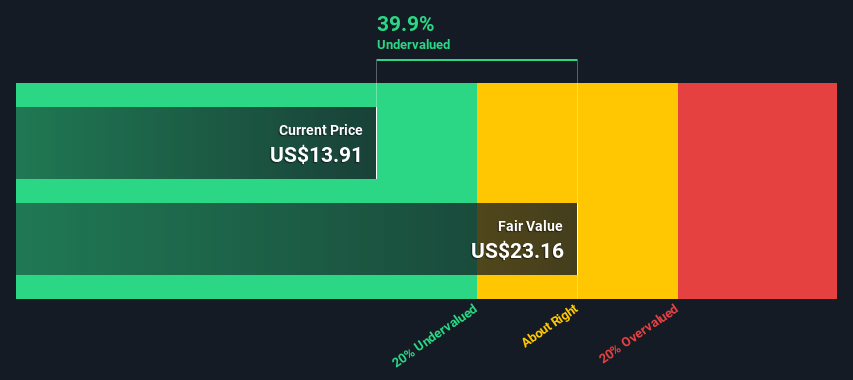- United States
- /
- Auto
- /
- NYSE:F
Ford Motor Company (NYSE:F) Remains Undervalued Following a Positive Earnings Surprise
Ford Motor Company (NYSE:F) has been gaining interest lately. After a successful launch of the all-electric F-150 truck, the company posted surprising Q2 earnings.
Yet, the company remains at a modest valuation. Although reasonable by historical standards, the P/E valuation of 16 can be considered low at the moment. We will estimate the stock’s intrinsic value by using a Discounted Cash Flow (DCF) model.
Q2 Earnings Surprise
Q2 earnings per share surprised by coming at US$0.13 versus the estimated negative US$0.04. Automotive revenue of US$24.12 climbed 45.1% Y/Y and beat the estimates for US$1.29b.
The company raised 2021 EBIT guidance by 50%, aiming at US$9b in earnings. They are expecting the chip shortage to ease in the second part of the year.
Furthermore, Ford has a share in Rivian and Argo, which should IPO within a year. With their valuations in tens of billions, successful IPOs can provide significant tailwinds for the stock.
EV Orders are Piling Up
F-150 Lightning truck reservations are now over 120,000, while Ford Maverick, a $20,000 compact hybrid pickup, has 80,000 orders. Obviously, the company is leveraging strong brand loyalty to keep the customers but also taking advantage of the production scale to keep the price attractive.
Currently, EV sales are relying only on 3 models: Mach-E SUV, F-150 Hybrid, and Escape Plug-in Hybrid. However, as F-150 Lightning goes on sale in 2022, this will mark a potential pivot toward the new full electric line-up.
Finding the Value
Remember, there are many ways to estimate a company's value, and a DCF is just one method.If you still have some burning questions about this type of valuation, look at the Simply Wall St analysis model.
View our latest analysis for Ford Motor
Step by step through the calculation
We will use a two-stage DCF model, which, as the name states, takes into account two stages of growth. The first stage is generally a higher growth period which levels off heading towards the terminal value, captured in the second steady growth period. To start with, we need to estimate the next ten years of cash flows. Where possible, we use analyst estimates, but when these aren't available, we extrapolate the previous free cash flow (FCF) from the last estimate or reported value. We assume companies with shrinking free cash flow will slow their shrinkage rate and that companies with growing free cash flow will see their growth rate slow over this period. We do this to reflect that growth tends to slow more in the early years than in later years.
A DCF is all about the idea that a dollar in the future is less valuable than a dollar today, so we discount the value of these future cash flows to their estimated value in today's dollars:
10-year free cash flow (FCF) forecast
| 2022 | 2023 | 2024 | 2025 | 2026 | 2027 | 2028 | 2029 | 2030 | 2031 | |
| Levered FCF ($, Millions) | US$4.96b | US$7.82b | US$9.33b | US$9.64b | US$9.90b | US$10.1b | US$10.4b | US$10.6b | US$10.8b | US$11.1b |
| Growth Rate Estimate Source | Analyst x4 | Analyst x3 | Analyst x2 | Analyst x2 | Est @ 2.7% | Est @ 2.48% | Est @ 2.34% | Est @ 2.23% | Est @ 2.16% | Est @ 2.11% |
| Present Value ($, Millions) Discounted @ 11% | US$4.5k | US$6.3k | US$6.7k | US$6.3k | US$5.8k | US$5.3k | US$4.9k | US$4.5k | US$4.1k | US$3.8k |
("Est" = FCF growth rate estimated by Simply Wall St)
Present Value of 10-year Cash Flow (PVCF) = US$52b
After calculating the present value of future cash flows in the initial 10-year period, we need to calculate the Terminal Value, which accounts for all future cash flows beyond the first stage. For several reasons, a very conservative growth rate is used that cannot exceed that of a country's GDP growth. In this case, we have used the 5-year average of the 10-year government bond yield (2.0%) to estimate future growth. In the same way, as with the 10-year 'growth' period, we discount future cash flows to today's value, using a cost of equity of 11%.
Terminal Value (TV)= FCF2031 × (1 + g) ÷ (r - g) = US$11b× (1 + 2.0%) ÷ (11%- 2.0%) = US$120b
Present Value of Terminal Value (PVTV)= TV / (1 + r)10= US$120b÷ ( 1 + 11%)10= US$41b
The total value is the sum of cash flows for the next ten years plus the discounted terminal value, which results in the Total Equity Value, which in this case is US$93b. To get the intrinsic value per share, we divide this by the total number of shares outstanding. Relative to the current share price of US$13.9, the company appears quite good value at a 40% discount to where the stock price trades currently. The assumptions in any calculation significantly impact the valuation, so it is better to view this as a rough estimate, not precise down to the last cent.

Important assumptions
The calculation above is very dependent on two assumptions. The first is the discount rate, and the other is the cash flows. You don't have to agree with these inputs. I recommend redoing the calculations yourself and playing with them. The DCF also does not consider the possible cyclicality of an industry or its future capital requirements, so it does not fully picture a company's potential performance.
Given that we are looking at Ford Motor as potential shareholders, the cost of equity is used as the discount rate rather than the cost of capital (or the weighted average cost of capital, WACC), which accounts for debt. In this calculation, we've used 11% based on a levered beta of 2.000. Beta is a measure of a stock's volatility compared to the market as a whole. We get our beta from the industry average beta of globally comparable companies, with an imposed limit between 0.8 and 2.0, which is a reasonable range for a stable business.
Looking Ahead:
While important, the DCF calculation shouldn't be the only metric you look at when researching a company. It's not possible to obtain a foolproof valuation with a DCF model. Preferably you'd apply different cases and assumptions and see how they would impact the company's valuation. For instance, if the terminal value growth rate is adjusted slightly, it can dramatically alter the overall result. What is the reason for the share price sitting below the intrinsic value? For Ford Motor, we've compiled three fundamental aspects you should further research:
- Risks: Take risks; for example - Ford Motor has 1 warning sign we think you should be aware of.
- Future Earnings: How does F's growth rate compare to its peers and the broader market? Dig deeper into the analyst consensus number for the upcoming years by interacting with our free analyst growth expectation chart.
- Other High-Quality Alternatives: Do you like a good all-rounder? Explore our interactive list of high quality stocks to get an idea of what else is out there you may be missing!
PS. The Simply Wall St app conducts a discounted cash flow valuation for every stock on the NYSE every day. If you want to find the calculation for other stocks, search here.
New: AI Stock Screener & Alerts
Our new AI Stock Screener scans the market every day to uncover opportunities.
• Dividend Powerhouses (3%+ Yield)
• Undervalued Small Caps with Insider Buying
• High growth Tech and AI Companies
Or build your own from over 50 metrics.
Have feedback on this article? Concerned about the content? Get in touch with us directly. Alternatively, email editorial-team@simplywallst.com
Simply Wall St analyst Stjepan Kalinic and Simply Wall St have no position in any of the companies mentioned. This article is general in nature. We provide commentary based on historical data and analyst forecasts only using an unbiased methodology and our articles are not intended to be financial advice. It does not constitute a recommendation to buy or sell any stock and does not take account of your objectives, or your financial situation. We aim to bring you long-term focused analysis driven by fundamental data. Note that our analysis may not factor in the latest price-sensitive company announcements or qualitative material.

Stjepan Kalinic
Stjepan is a writer and an analyst covering equity markets. As a former multi-asset analyst, he prefers to look beyond the surface and uncover ideas that might not be on retail investors' radar. You can find his research all over the internet, including Simply Wall St News, Yahoo Finance, Benzinga, Vincent, and Barron's.
About NYSE:F
Ford Motor
Develops, delivers, and services Ford trucks, sport utility vehicles, commercial vans and cars, and Lincoln luxury vehicles worldwide.
Solid track record established dividend payer.
Similar Companies
Market Insights
Community Narratives


Recently Updated Narratives

Astor Enerji will surge with a fair value of $140.43 in the next 3 years

Proximus: The State-Backed Backup Plan with 7% Gross Yield and 15% Currency Upside.


A case for for IMPACT Silver Corp (TSXV:IPT) to reach USD $4.52 (CAD $6.16) in 2026 (23 bagger in 1 year) and USD $5.76 (CAD $7.89) by 2030
Popular Narratives


MicroVision will explode future revenue by 380.37% with a vision towards success


The company that turned a verb into a global necessity and basically runs the modern internet, digital ads, smartphones, maps, and AI.


